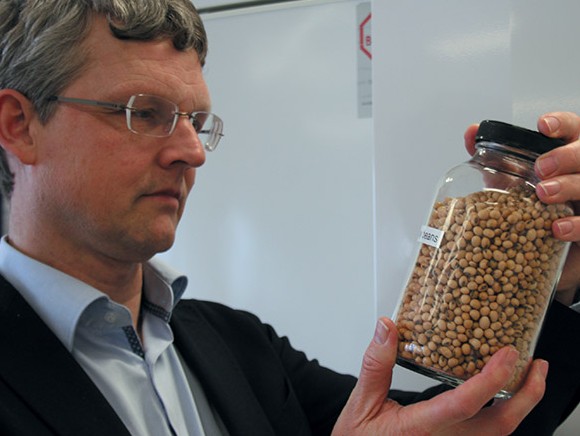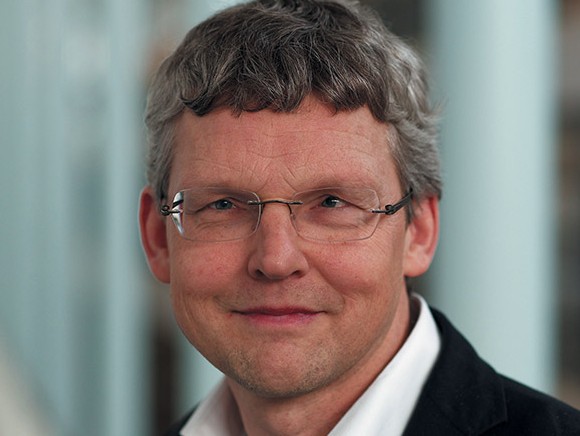
To produce our daily foodstuffs, grain, soya beans and potatoes are separated into ingredients, or ‘fractions’, that are as pure as possible. That is inefficient and not particularly sustainable, according to Prof. Dr. Atze Jan van der Goot. “There are hundreds of ingredients in these raw materials that are currently not being used, even though their more complex structure is very beneficial.” It’s time for change.
In much of the world, food has become safer, more abundant, more varied and more affordable over the past 50 years. But at the same time those foods encourage a less healthy diet, involve a lot of energy and raw materials in their production and have a significant impact on the environment. With fossil energy sources now becoming increasingly scarce and the world’s population and meat consumption on the rise, there is strong growth in demand for sustainable alternative sources of protein. The million dollar question is: which innovations are necessary if we are to be able to provide sufficient, safe food for nine billion people worldwide in 2050?
There is no doubt that we will have to obtain proteins and other nutrients from algae, insects and seaweed. But, as research has shown, there are also gains to be made in terms of the traditional raw materials: “Less-refined ingredients will make food products more sustainable,” claims Prof. Dr. Atze Jan de Goot, who took up the role of Professor of Protein Structuring and Sustainability on 10 March.
‘In my opinion, there’s no stopping this trend now’
“The food industry has become skilled at separating agricultural products – such as potatoes, wheat or soya beans – into ingredients such as proteins, oils, fats, carbohydrates and residual products. The production process and the set-up of the food chain requires ingredients and food products to have a certain shelf life. Longer shelf life is achieved through intensive sterilisation, the use of preservatives and by storing ingredients in dried form. Many industrially produced foodstuffs such as soups, sauces and emulsion-based products are made from dry and extremely pure, refined ingredients. The advantage of these refined ingredients is that they have a pre-defined chemical composition and a wide range of applications.”
“The downside of this system is that it has a major environmental impact. It consumes a lot of energy, especially for all the dehydration activities. The current processes were designed at a time when there was a surplus of energy and raw materials. Now that energy and raw materials are becoming increasingly scarce, we need to find other solutions. For example, to find a more sustainable dehydration method, experiments are being conducted with the use of heat pumps, which could result in less energy being used in the drying process. And the use of solar power appears to offer a lot of potential too.”
“That it’s often not even necessary to separate raw materials into very pure ingredients! It’s also possible to obtain fractions that are good enough to make food using milder separation techniques which preserve more of the original structure. That not only reduces the loss of energy and raw materials, but also results in healthier products. Today’s products can soon lead to obesity yet at the same time there is a chance of malnutrition due to a lack of micronutrients. That’s because the refining process frequently also eliminates micronutrients such as vitamins and minerals. Analysis has revealed that pure potato starch has hardly any nutritional value, whereas less-refined starch also contains vitamins, minerals and fibre that are beneficial to health. In another example relating to sugar beet leaves, while the current techniques can obtain proteins with 90 percent purity from the leaves, they can only extract 6% of the total protein contained in the leaf. It’s important to produce ingredients sustainably because, for many food products, the ingredients largely determine the sustainability of the product itself.”
“Much research is being done to develop alternative separation methods. One example of such a process is shear-induced separation of wheat flour, which results in the components of wheat proteins (gluten) and starch. Although water is still essential in this separation process, this example shows that much less water is required. The concept was discovered around 10 years ago in our group, but so far it hasn’t been applied to other product industries and processes. That remains the challenge.”
“Nowadays, we’ve shifted so far in terms of safety and standardised processes that we pay a high price for that in the form of less sustainability. As the purity of ingredients increases, so too does the intensity of the processes required, consuming a lot of energy and water. Additionally, this leads to bigger waste flows because the yield often decreases in relation to higher purity: the greater the purity of the end product, the more raw material that is required to produce one kilogram of it. So a different approach can offer companies big advantages and cost savings. I realise that changes will have to be initiated gradually. Perhaps suppliers of raw materials and manufacturers of end products will decide to intensify their collaboration or to move their production facilities closer together. This would not only reduce high transport costs but would also eliminate the need for energy-intensive processes of first dehydrating the ingredients and then rehydrating them. Large multinationals such as Cargill and Unilever are already taking steps in this direction. Furthermore, we’re seeing that these kinds of companies are increasingly becoming knowledge suppliers. Consumers don’t want any E numbers in their products and are favouring local producers. Links are already being eliminated from the chain here and there. In my opinion, there’s no stopping this trend now.”
‘It’s often not even necessary to separate raw materials into very pure ingredients’
“Meat production takes up a lot of energy and land simply because the conversion of vegetable protein to animal protein is not very efficient. Projects are underway all over the world, searching for meat alternatives in order to limit the negative effects of meat. Consumers are more inclined to purchase meat replacements when the texture of these sustainable alternatives mimics that of meat. At the end of last year, we forced a breakthrough in this area together with De Vegetarische Slager with a meat replacement based on soy proteins. Notably, we achieved the best results with a soya fraction that had not been completely purified. In terms of sustainability, health and technological functionality, the use of less-refined fractions from plant material now appears to be the most logical option. I see this as a nice example of applying the theory in practice.”

“First of all, I want my work to be beneficial. Optimising the current production process is an important step forwards, but that alone won’t be enough to enable us to feed the whole world in the future. I want to find out how processes and products can be made healthier and more sustainable; how can we make optimal use of crops? Where can we eliminate process inefficiency? I investigate what is possible. To be honest, I pay less attention to whether the solutions are financially viable, because the current economic feasibility is determined by today’s energy and raw materials prices and the taxes imposed on pollution. All those factors are sure to change in the future, and that will affect the viability of new technologies.”
Source: © WUR